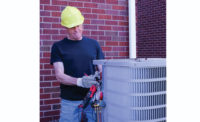It is this threat that has Boomers and the next generations alike sitting around their computers reading reports from the United States Bureau of Labor and Statistics (BLS) that warn a trained workforce gap is coming and the HVAC industry will not be spared. What can be done to avoid this potential disaster?
Get a New Attitude
Acknowledging that a gap is coming could arguably be a first step in avoiding it. Worrying about it without taking action, likely won’t help. In fact, it might be time to get a new attitude altogether. Instead of seeing this as a labor shortage, it might be more beneficial to refocus and look at the growth expected over the next decade — between 18 to 26 percent, according to the BLS.
According to Chris Compton, lead faculty, project director, and content development manager for HVACRedu.net, the gap in recruitment and projected need hasn’t changed too much in the 30-plus years he has been in the industry.
“The industry does provide a lot of lip service to the issue, but has done little to organize and approach the issue as an industry with a coordinated and collective voice,” he said. “Until that happens, it is doubtful that things will really change.”
The current shortage predictions show that of the approximately 78 million Baby Boomers, roughly 40 percent will become eligible for retirement over the next 10 years. The new workforce coming up only has about 40 million new workers to offer. Do the math.
“As America grows older, we will be building more hospitals, pharmacies, retirement communities, etc.,” said Howard Weiss, marketing director for the ESCO group. “Who will install the HVACR equipment in those facilities?”
That question is one that the industry has been addressing for years. In an effort to change the Bubba stereotype that those outside the industry can mistakenly associate with HVAC technicians, industry sectors have worked together to clean up the look, the idea, and the qualifications necessary to be a successful and certified HVAC technician.
It seems that these efforts are beginning to pay off. U.S. News & World Report placed HVAC technician in its “50 Best Jobs of 2011” citing that, “this career should have strong overgrowth over the next decade.” It continued with a full article dedicated to the explanation of the job and its benefits. (Read the full article at http://bit.ly/qgzUSf.)
The BLS is also reporting favorably about the prospects of being an HVAC technician.
“Job prospects for HVACR mechanics and installers are expected to be excellent, particularly for those who have completed training. Employment is projected to grow much faster than the average.”
Despite the good press and upward growth trend, contractors are reporting that finding technicians is a challenge. For some, like Ken Bodwell, vice president of Innovative Service Solutions, in Orlando, Fla., it is difficult to find the right type of technicians.
“What we have found is that the good technicians have been held onto by their employers and those that are seeking a job have some sort of baggage,” he explained. “There is an abundance of residential applicants, but finding senior technicians or those technicians that demonstrate a desire to tackle larger equipment are difficult to find.”
Others, like Ann Kahn, president of Kahn Mechanical Contractors in Dallas, see the industry’s aging problem and are concerned for what happens over the next five to 10 years. “Unless we are able to devise a way to demonstrate to high school students that they can make a good living at the trade,” she said, “there is only one word to describe the HVACR industry’s future workforce…aging.”
Find New Recruits
Area high schools seem to be the most logical recruiting centers for new trainees, but contractors like Kahn, and associations alike have run into some roadblocks.
“Several years ago North Texas ACCA participated in high school career days and even helped build an HVAC lab at a Dallas high school,” explained Kahn. “Sad to say most of the high schools in our area are dropping this training and the counselors continue to not present an HVAC career as an option.”
John Whittaker, president and owner of Mechanical Services Co. Inc. in Virginia Beach, Va., is having a hard time convincing parents and students that an HVAC career is a valid career.
“College is pushed at students too hard,” he said.
This is a point that Weiss brought up in a recent discussion about the future of HVAC education. He cited the BLS report that said only 20 percent of all American jobs require a four-year degree or higher.
“While these are important jobs, we need to keep in mind that means that 80 percent of the jobs do not require that education path,” he said. “In fact, the average college student spends five years in college, spends $100,000, and owes nearly $70,000 after graduation.”
According to Eric Knaak, vice president of service for Isaac Heating & Air Conditioning in Rochester, N.Y., the expense of college is taking its toll on the average middle class family. He recently read in a weekend newspaper that the national college debt has surpassed the national credit card debt. This fact may bring a new motivation that previously wasn’t a factor for many high school students.
“I think we are going to see more people getting into the trades as college becomes less affordable and as more people realize the potential in the trades,” he explained. “The price of college is going to force some people to re-think what they do for their careers or at the least what path they choose.”
Many contractors and associations agree that changing the perception of an HVAC career in the minds of parents, students, and guidance counselors still remains at the top of their agendas.
Kathy Corr, director of strategic relationships at North America, Technician Excellence (NATE), came from a background of education in career and technical colleges, as well as at the high school level. She explained that many parents struggle with the idea of their child not going to college.
“The HVACR industry, however, is definitely a great career ladder, that includes, technicians, engineers, and entrepreneurs,” said Corr. “NATE encourages two-year programs to have their students take the Core exam before they graduate, so that after a little more experience, they will be able to take their NATE specialty exam.”
One of the other larger concerns about finding new recruits in high schools stems further than parents and guidance counselors and highlights an issue that manufacturers are beginning to address.
Paul Sammataro, president of Samm’s Heating and Air Conditioning in Plano, Texas, pointed out that there is a vastly different work ethic in today’s 18- to 20-year-olds. “The point and click mentality and starting at the top with an entitlement attitude is prevalent,” he said.
Bodwell agreed. “In the past, we put the blame on the guidance counselors; but today I think most young people look at hard work and rough environments as not glamorous,” he said. “The more technology changes the more our industry will become more glamorous and in the spotlight where today’s computer savvy young people are. I’m hoping that the next generation looks at employment opportunities within the HVACR industry as a career path that does not require four years of expensive education.”
Celebrate Achievement
Just because a career doesn’t require four years or more of college, doesn’t mean that there is no training or skill involved with that career. Bringing prestige to those that choose the HVACR industry as a career can help shed a positive light on the industry and those establishments committed to acknowledging HVACR as a career path, not just a job.
Peter Marzec, the national chairman of the United Association Union of Plumbers, Fitters, Welders, and HVAC Service Techs (UA) International Apprenticeship Program understands these principles well. He recently oversaw apprentice competitors from across the nation and Canada gathered to faceoff in the UA International Apprentice Contest — a one day competition that he calls “the super bowl of the trades.” Marzec was one of many on site at the Great Lakes Regional Training Center on the campus of Washtenaw Community College in Ann Arbor, Mich. HVAC service techs, plumbers, pipefitters, welders, and sprinkler fitters battled to prove that they were the best in their field. At the end of the day, the HVAC service tech winner was James Cossart, Local 342, Concord, Calif.
Along with this event, hundreds of technicians and contractors were continuing their education with the goal of completing the UA Instructor Training Program; not only investing in future technicians, but also in future technician educators.
Get Involved
The approaching, potential labor shortage could prove to be one of the HVACR industry’s greatest tests. With the combined effort of contractors, distributors, manufacturers, and associations, however, the industry may be able to stave off the approaching labor emergency.
“… This concludes this test of the Emergency Broadcast System.”
Read the full BLS report at http://1.usa.gov/mZ6IXZ.
Sidebar: Out of the Classroom
Fall Apprenticeship Courses began Sept. 6 with HVACRedu.net. According to the company, this is the first online apprenticeship training program in the country. The online program is the related training/educational component of registered apprenticeship programs that provide on-the-job training supervised by a qualified journeyman. Courses include RSES tutorials.
HVACRedu.net’s Online Apprenticeship Related Training Program is recognized by HVAC Excellence, Idaho State, Virginia State, Maryland State, Arkansas State, and satisfies all the requirements for the U.S. Department of Labor Registered Apprenticeship Program.
All courses are guided by qualified industry experts in a cohort setting. Courses are available on a revolving schedule so students may enter the program at the beginning of any course.
Publication date: 09/12/2011









